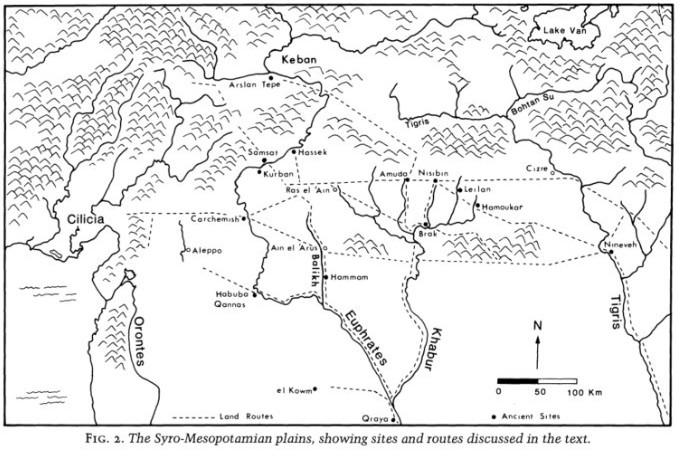|
Other Archaeological Sites / The Neolithic of the Levant (500 Page Book Online)
The Uruk Expansion: Cross Cultural Exchange in Early Mesopotamian Civilization
Excerpts and Definitions and Addendums:
ProofRead and Updated May 26th 2019
Although short-lived, this foray was to have important repercussions on the development of the indigenous societies with which it came into contact and this in turn contributed to the abandonment of the (*)intrusive settlements shortly before the end of the Uruk Period. By and large the hinterlands away from the intrusive Uruk settlements were left untouched (though not unaffected). There is a great difference between the sizes of the intrusive Uruk enclaves and those of the indigenous Late Chalcolithic sites in their surroundings. Many preexisting sites were not much larger than villages and the few more sizable contemporary Late Chalcolithic communities in the north pale by comparison with the enclaves. URUK ENCLAVES -- STATIONS -- OUTPOSTS Recognizable elements of Uruk material culture have long been reported from excavations across the high plains of northern Mesopotamia -- northern Syria and southeastern Anatolia ... The distibution of Uruk materials in indigenous settlements astride important highland routes is particularly clear in the case of sites in the principal intermontane valleys traversed by east-west routes across the Zagros Mountains. A similar pattern is evident in southeastern Anatolia and the eastern Taurus Mountains (Arslan Tepe etcetera). Uruk artifacts are found in two distinct types of sites across the northern planes: [1] sites in which isolated Uruk objects appear in the context of an otherwise local late chalcolithic assemblage and [2] sites characterized by a cultural assemblage that is overwhelmingly southern Mesopotamian in origin and Uruk in type. The first can be understood as indigenous occupations in contact with Uruk settlements elsewhere. Examples are numerous and range from the Amuq Plain in northwestern Syria to Nuzi in the Kirkuk area of northeastern Iraq. The second however may be considered to represent intrusive settlements. Although the riverine locations of the "enclaves" would seem to suggest that a crucial factor determining their placement was control of the north-south waterways they are also oriented along east-west overland routes of communication across Syro-Mesopotamia known from classical times. Each it seems commands a historical juncture where the principal overland routes intersect the rivers. The location of Uruk enclaves at focal nodes of the lines of communication across the Syro-Mesopotamian Plains is indicative of their function: their settlement pattern seems efficiently suited only to control the flow of resources. Although some such as Tell Brak and Nineveh could have and most probably did tap into the considerable agricultural potential of their surroundings, the scattered distribution of the enclaves as a whole is an indication that neither the control of broad expanses of territory nor the efficient large scale exploitation of local agricultural resources was a primary consideration. Either of these goals would be reflected by a broader range of site sizes dispersed over a wider landscape --- a settlement pattern similar in fact to that documented for Uruk sites in the Susiana Plain [historically Elam]. STATIONS: Away from the larger enclaves are found much smaller isolated Uruk settlemants serving as links or stations alongside overland routes between the enclaves and the alluvium and also along important routes into the northern plains ... Their pattern of settlement is clearest on the Euphrates. Strung along the river are at least seven small sites characterized by overwhelmingly Uruk ceramic assemblages. OUTPOSTS: Outside of the geographical horizon of the Syro-Mesopotamian Plains large Uruk enclaves with their associated clusters are no longer found. What are found occasionally are small isolated outposts more similar in size to the stations. These are located deep in the highland astride some of the most important overland routes. Godin Tepe sits astride the Khorasan Road, historically the most important of the east-west routes across the Zagros Mountains into Iran, following the course of the Diyala Valley. Tepe Sialk is situated along the principal north-south route connecting Khuzestan and the other plains of southwestern Iran with the plain of Rayy near Tehran and ultimately Afghanistan. Intriguingly while some of the enclaves in the Syro-Mesopotamian plains evolved over a possibly significant span of time, the highland outposts appear to have a much more restricted chronological development that coincides with the very end of the period in which the enclaves flourished ... |

